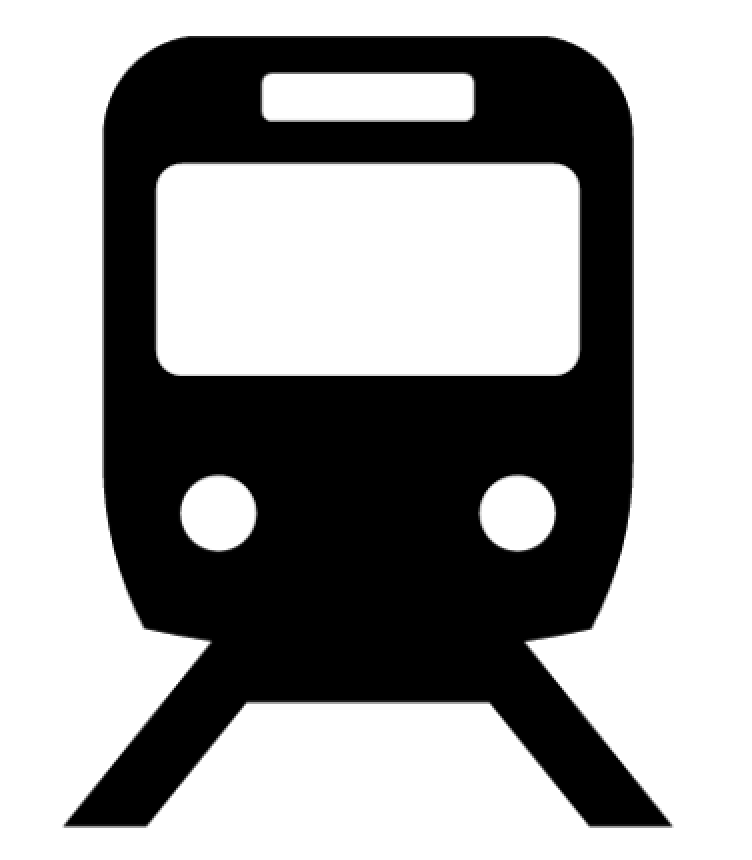|
DevonTrains2008
|
 |
« on: September 10, 2009, 20:31:07 » |
|
Have just returned from a trip to Italy and whilst there travelled by train between Salerno and Naples and vice-versa. Having heard good reports about Trenitalia (Italian Railways) I was looking forward to something similar to the efficient service provided by SNCF▸ in France. However, upon arrival at the station we found that as we were travelling outside of 'rush hour' we would have about a 1.5 hour wait for our train.
When we arrived back at the station, with around 10 minutes to spare before our train departed we found there was no information whatsoever in English with regards to ticketing procedure (tickets must be validated before travel but machines were not working anyway) and no information in English or Italian on the departure boards. There were also no staff at all on the station. We found this very suprising as this is the main station for the Amalfi Coast, linking with Naples and Rome which is reflected in the amount of English/German/French speaking tourists at the station - who were all equally lost.
When there were only a couple of minutes to go before our train we began to worry as no information had yet been displayed. Eventually the platform number was displayed as '2T' but there was no sign as to where this platform was. We finally found our platform due to an Italian shouting to the driver of the train, which was on a platform hidden around a corner with no signage whatsoever!
Upon boarding the train, we were shocked as it was covered in graffiti and had plastic 'classroom' type chairs - not exactly what we were expecting for a 1.5 hour journey! When the train called in at famous tourist sites, such as Pompeii no announcements were made at all which we also found very suprising.
After our day in Naples we headed back to the station, which is located next to Napoli Centrale and asked at the ticket office for information with regards to platform number and time of our train back to Salerno. We were told the train would arrive on platform 2 in 4 minutes - so we headed for platform 2, which incidentally had a sign saying 'Binario 2 - Salerno'
After we had waited about 20 minutes for our train an Italian who was standing on platform 1 shouted 'Salerno here' so we headed over the bridge in a panic, thinking we were going to miss the train. 30 minutes and 5 trains later - each of which the driver said 'the next one for Salerno' we were wondering about how were going to afford the taxi fare for the 70 km journey back to our resort - then finally the Salerno train came - incidentally, this man was helping out French, German and English tourists and also happened to be the only Italian travelling on the train - I wonder why?!
When we left Napoli Centrale, we spent about 10 minutes speeding up and slowing down before finally getting going to Salerno. Having arrived at the station in Naples at 6pm we arrived back in Salerno at around 8:30!
Although the trip costs ^6,60 return I would still not advise this as the best way to travel in Italy and would say that trains in Britain are far superior to our limited experience. I understand that Trenitalia may not all be this bad, we did see some really flashy 'Eurostar Italia' trains outside Napoli Centrale - maybe we are just treated to the mainly clean, modern and efficient service we experience on South West Trains WoEML▸ .
|
|
|
|
|
 Logged
Logged
|
|
|
|
|
grahame
|
 |
« Reply #1 on: September 15, 2009, 16:10:13 » |
|
Many thanks for that insite into Italian Railways from your visit. I note that although n-one has followed up your thread, dozens of people have read it (and people who read it via "most recent posts" don't even get counted in the stats!). More general note ... posts about wider area experiences are .... err .... very welcome in "The Wider Picture"  |
|
|
|
|
 Logged
Logged
|
Coffee Shop Admin, Chair of Melksham Rail User Group, TravelWatch SouthWest Board Member
|
|
|
|
Chris from Nailsea
|
 |
« Reply #2 on: April 12, 2010, 23:29:54 » |
|
From the BBC» : A landslide has derailed a train in north-eastern Italy, killing at least nine people and injuring about 30, Italian media say.
The accident occurred in a mountain valley near the winter sports town of Merano, close to the Austrian border.
Trees prevented the train plunging into a river, and firefighters are said to have used cables to secure the wagons.
Officials say the landslide may have been caused by a leaking water pipe further up the hillside.
An investigation is under way.
The accident took place at around 0900 (0700 GMT) on the line from Castelbello to Laces, not far from the city of Bolzano.
The authorities say the mass of water, mud and rock came without warning, burying the regional train as it passed through the alpine valley, the BBC's Bethany Bell reports from the scene.
The death toll had been put at 11, although this was later revised down to nine because of what provincial governor Luis Durnwalder said was a "counting error".
But he warned Ansa news agency that the toll was not final as "there could still be someone buried in the mud".
The train driver is understood to be among the dead. The most seriously injured have been taken by helicopter to nearby hospitals.
Rescuers dug frantically with shovels and pickaxes in at least one mud-filled carriage to try to reach the victims, Ansa reported.
Eyewitness Alex Rowbotham told the BBC: "The front of the train, the cab, is not there at all and the train is hanging off the rails about five metres from the river.
"It is now only a few trees that are holding up the train and preventing it falling into the river."
He said the train was on the other side of the Adige river to the main road, and it appeared as if rescuers were building a pontoon across the river to enable them to carry across necessary equipment.
Thomas Widmann, transport adviser to the Bolzano provincial government, told Sky Italia that the landslide appeared to have been caused by an irrigation pipe that burst, piling rocks, debris and water on to the oncoming train.
The railway line, inaugurated in 2005, is one of the most modern in the country, Ansa said.
It runs at the foot of an alpine valley with mountains towering up to 3,000m (9,850ft) above.
|
|
|
|
|
 Logged
Logged
|
William Huskisson MP▸ was the first person to be killed by a train while crossing the tracks, in 1830. Many more have died in the same way since then. Don't take a chance: Stop, Look, Listen.
"Level crossings are safe, unless they are used in an unsafe manner." Discuss.
|
|
|
|
Brucey
|
 |
« Reply #3 on: July 07, 2013, 12:32:32 » |
|
Having been round various cities in Northern Italy in the last week, using a variety of different services, I'm prepared to conclude the system is divided into two classes, but there are plenty of things we can learn from this.
My first journey was on a mixture of Regionale and Regionale Veloce trains. These are very reasonably priced, typically by distance (e.g. I paid ^15.85 for a 227km journey, approximately 9.67p per mile for comparison to UK▸ prices), with no peak/off-peak times. The fare is the same all day. There are no return tickets, only singles. A ticket is valid for two months and must be validated before travel. Once validated, it is valid for the period of time shown on the ticket (six hours in my case). The ticket machines are very intuitive, provided journey details and all available fares. Wouldn't it be refreshing to be able to have a system like this in the UK?
That's where the positives end for this journey. Arriving at the platform, the train was an EMU▸ which was covered in graffiti. The platform information board told me this was "Regionale 24774 Treviglio". No departure time, no calling at stations, no other information. The train had no air conditioning (or none switched on/working) and was very overcrowded. The next two services were both Regionale Veloce services, loco hauled, again very hot, covered in graffiti both inside and out. None of these services had any announcements, automated or otherwise. None of these trains ran to time, with no-one particularly concerned by the late running. During this journey, I did wonder if I should be allowed to complain about my daily commute in future.
My next service was a joint DB» /OBB service down to Venice. I had already purchased a ticket online, however my friend hadn't. We had some trouble getting a ticket for this service in Trento. The Trenitalia office and machines will not sell tickets for DB/OBB. There is a second station which has a DB ticket window, however this is closed on Sunday. In the end, we spoke to the conductor before boarding who sold a standard priced ticket. The train was clearly older stock that had been refurbished, but was very comfortable with all manual announcements in German and English (surprisingly no Italian).
Final journey was on a Frecciabianca. These are what the Italians previously called Eurostar. The fare was substantially higher (^37.50 walk-up for a 250km journey, however I paid ^19.00 advance in 1st class). The train was air conditioned, comfortable and had automated announcements in Italian and English.
These journeys actually made me think quite carefully about the British fares system. Although confusing, once you have bought a ticket, it can be used on any valid train on a valid route. This is clearly not the case in Italy, where a separate ticket must be purchased for "premium" services. This was rather annoying on my journey to Trento, where I wished to take the Frecciabianca for part of the journey and DB/OBB for the third leg but ended up on Regionale trains for the whole journey for simplicity.
We are also lucky with the automated announcements. Yes, we probably have far too many, but I'd rather know where I am than not. Especially considering Italian railway stations have very few name boards along the platforms (one station we stopped at only had one at each end, nothing in the middle).
When people say Britain would be better off with a state run railway, I think they should pay a visit to Italy and ask themselves what they prefer, especially when you consider the rather dated and uncomfortable local services.
|
|
|
|
|
 Logged
Logged
|
|
|
|
|
eightf48544
|
 |
« Reply #4 on: July 07, 2013, 15:51:11 » |
|
A two teir railway is becoming the norm in Europe.
High speed Inter City with it's own fare tructure and Regional services which are becoming increasingly dependant on local "Council" funding.
Thus in France you have the TGVs▸ and some departments with quite good regional services but in others hardly any.
Germany is more consistent with ICE/IC▸ operated by DB» (Fernwerk?) and RE▸ /RB mostly operated as concessions from the Lander by a variety of operators including DB. Many of the private operators have purchased new units for their service. The operators agree to run so many thousand train kms a year.
Generally Regional services in Germany are pretty good and cheap especialy with the Lander tickets which give all day tavel on all local services and some tram systems as well, for up to 5 people for around E30.
One casualty amongst these changes are cross border services especialy local routes. This is particularly true between France and Belgium.
There is also now no through train from Ljubljana to Venice which when when we caught was a Slovinian tilting train. The quickest journey now is train to Villach and BUS!
|
|
|
|
|
 Logged
Logged
|
|
|
|
|
chuffed
|
 |
« Reply #5 on: April 22, 2016, 17:44:12 » |
|
Just back from 10 days trundling around northern Italy by Regionale local trains for the princely sum of 1 euro for every 10km. Spent 154 euros so that equates to 1,540 km. Used Bologna as a base... terrific,,,,went to Venice twice, Florence 4 times, Ravenna, Siena, Mantua, Verona and Rimini.
Used the Freccirossa to go from Bologna to Florence ( booked in advance through Italiarail) for11 euros and it takes 30 mins. The more conventional one takes 90 minutes using six to a compartment IC▸ trains, while the find of the week was the 3hr whizz into the mountains between Bologna and Florence via Porretta Terme using these Alstom EMU▸ Jazz trains that are just celebrating their 2nd birthday. Mentioned as a scenic railway journey of Europe in the European Rail Timetable.
Found this article online but the pictures won't reproduce.
THE first of 70 Jazz emus ordered in November 2012 from Alstom by Italian State Railways (FS) under a ^450m contract was on show on March 27 at Rome Termini station.
The train was presented to FS CEO▸ Mr Mauro Moretti (pictured) together with representatives from the Italian regions where the trains will operate.
The trains will be supplied in two different lengths ^ 54 trains will have five cars and 16 trains four cars, and four configurations. The commuter version will have plenty of space for standing passengers, while the regional configuration will have more seats, the regional express trains will have a higher level of comfort, and the airport rail link trains will have a greater proportion of space for luggage. However, the trains are designed so that the internal layout can be modified in the future.
The name Jazz was chosen following an online survey on the FS website, and follows a musical theme adopted by FS for its trains, namely Minuetto and Vivalto. The photo illustrates the striking livery chosen for the trains.
|
|
|
|
|
 Logged
Logged
|
|
|
|
|
broadgage
|
 |
« Reply #6 on: July 12, 2016, 12:36:42 » |
|
10 feared lost as two trains collide on a single track railway.
Aerial pictures show several carriages substantially destroyed.
Very sad.
No news as yet re suspected cause of the tragedy.
(source is BBC» news site, please be aware that this is a very early report and might later be found to be inaccurate.)
|
|
|
|
|
 Logged
Logged
|
A proper intercity train has a minimum of 8 coaches, gangwayed throughout, with first at one end, and a full sized buffet car between first and standard.
It has space for cycles, surfboards,luggage etc.
A 5 car DMU▸ is not a proper inter-city train. The 5+5 and 9 car DMUs are almost as bad.
|
|
|
|
ChrisB
|
 |
« Reply #7 on: July 12, 2016, 13:28:59 » |
|
|
|
|
|
|
 Logged
Logged
|
|
|
|
|
broadgage
|
 |
« Reply #8 on: July 12, 2016, 14:16:59 » |
|
Death toll now reported as being 20
|
|
|
|
|
 Logged
Logged
|
A proper intercity train has a minimum of 8 coaches, gangwayed throughout, with first at one end, and a full sized buffet car between first and standard.
It has space for cycles, surfboards,luggage etc.
A 5 car DMU▸ is not a proper inter-city train. The 5+5 and 9 car DMUs are almost as bad.
|
|
|
|
SandTEngineer
|
 |
« Reply #9 on: July 12, 2016, 17:21:53 » |
|
Yes, very sad and disturbing. Reminds me too much of Ladbroke Grove (which I missed by two trains worth).
|
|
|
|
|
 Logged
Logged
|
|
|
|
|
ChrisB
|
 |
« Reply #10 on: July 12, 2016, 20:41:58 » |
|
Now 23....
|
|
|
|
|
 Logged
Logged
|
|
|
|
|
stuving
|
 |
« Reply #11 on: July 13, 2016, 20:56:22 » |
|
I've now seen or heard it reported several times that there was no "automatic signalling" system on this line, and that safe operation of the single track section relies on telephone calls between adjacent stations. That might be a telegraphic interlock or token system, though none of the reports suggests that. That does seem a surprise, whatever you think about southern Italy, given that the line was built (in its current standard-gauge form) in 1965. This Reuters report explains that EU» funding has been available since 1999 to double this part of the line, but the Italian way of doing things has so far done nothing to claim it (you are allowed to be rude about that). So perhaps signalling upgrades were held up from well before that, while the project was being planned. Mind you, on other parts that have already been doubled, the signals do look a bit primitive - single aspect? |
|
|
|
|
 Logged
Logged
|
|
|
|
|
Oxonhutch
|
 |
« Reply #12 on: July 14, 2016, 08:01:05 » |
|
Common to many European countries the line is reported (BBC» ) to be Telephone Block which relies on operators reaching a complete understanding. As this is subject to human frailty, it is destined to fail. Hence our various physical token systems which are harder to defeat. They are not though undefeatable as in the case of Abermule. |
|
|
|
|
 Logged
Logged
|
|
|
|
|
Chris from Nailsea
|
 |
« Reply #13 on: July 14, 2016, 23:09:31 » |
|
An update, from the BBC» : Italy rail crash: Andria station master 'let crash train go'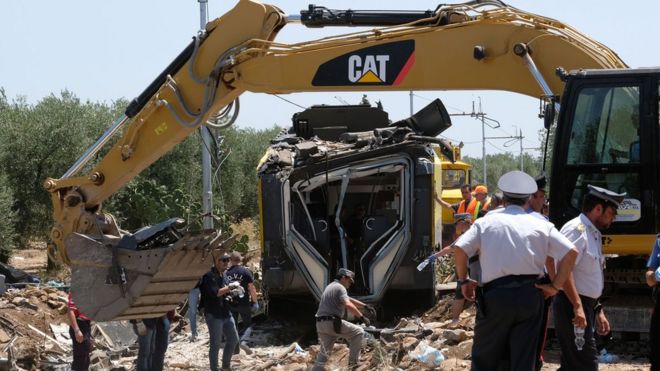 The crash was Italy's worst rail disaster since 2009A station master in southern Italy has admitted he allowed a train to go on a single track, minutes before a deadly collision with an oncoming train. The crash was Italy's worst rail disaster since 2009A station master in southern Italy has admitted he allowed a train to go on a single track, minutes before a deadly collision with an oncoming train.Twenty-three people died and 52 others were hurt in the head-on crash on a single track between Andria and Corato in the Apulia region on Tuesday. "I let the train go, I was the one who gave the signal," Andria station master Vito Piccarreta told Italian media. But he was adamant he was not the only one at fault. Mr Piccarreta, a railway employee with 24 years of service, was quoted by La Stampa and other newspapers as saying: "I'm not the only one at fault, everyone is blaming me. But I'm a victim too." 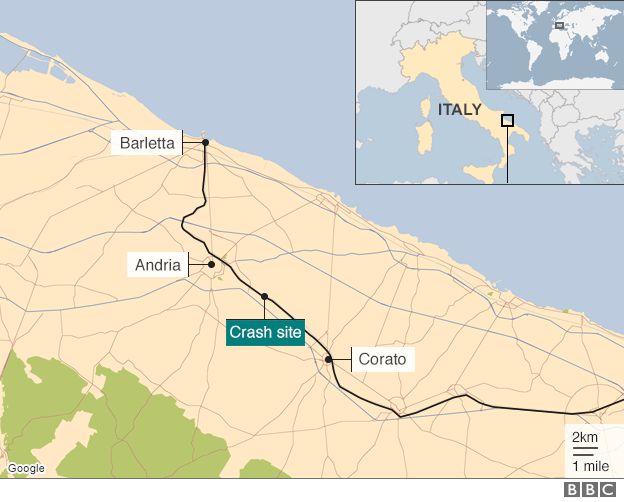 While he and the station master at Corato have both been suspended as part of an investigation into multiple manslaughter, local prosecutors are also looking into safety procedures on the single-track line and why the line had not been upgraded to a double track. "The investigation will not only look into human error, we must examine all possibilities," said prosecutor Francesco Giannella. The rail line north of Bari relies on an antiquated phone alert system dating back to the 1960s, in common with some 600km (370 miles) of regional track elsewhere in Italy, the government says. An estimated 2,700km of Italy's rail infrastructure remains single track. An investigator told La Reppublica newspaper that the problem was not the single track but a control system that had been automated everywhere else. While the number of trains has increased in the Bari area, the system still relies on an outdated reliance on station masters and drivers. 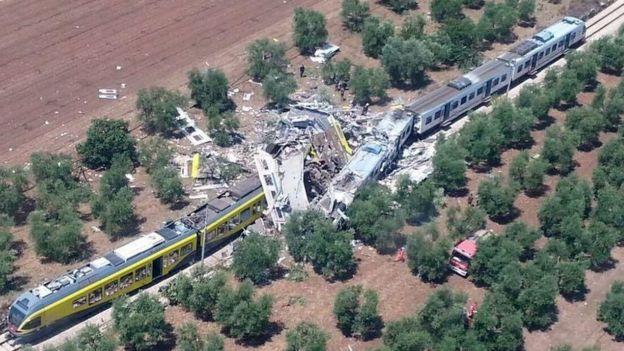 The crash took place on one of Italy's many single-track lines, however most of them have upgraded safety systems The crash took place on one of Italy's many single-track lines, however most of them have upgraded safety systemsIt has emerged that because rail services were late, three trains were travelling in the area at the time of the crash. Mr Piccarreta said he was unaware of the extra train travelling from Corato. Although the bidding process to update the track and safety systems north of Bari is due to start shortly, millions of euros in EU» funding allocated in 2009 to replace single-track lines has gone unspent. The company that runs the line north of Bari, Ferrotramviaria, has blamed Italian bureaucracy for the lack of progress. Funerals for the victims of the disaster are due to begin taking place at the weekend. Among the victims were a mother and daughter found by rescuers beside the wrecked trains in the immediate aftermath of the crash. The Andria rail crash was Italy's worst since a train carrying gas derailed in Viareggio in 2009, claiming the lives of more than 30 people who lived in the area. |
|
|
|
|
 Logged
Logged
|
William Huskisson MP▸ was the first person to be killed by a train while crossing the tracks, in 1830. Many more have died in the same way since then. Don't take a chance: Stop, Look, Listen.
"Level crossings are safe, unless they are used in an unsafe manner." Discuss.
|
|
|
|
stuving
|
 |
« Reply #14 on: March 22, 2017, 17:51:35 » |
|
From the BBC» :Train derails in Switzerland trapping passengers 36 minutes ago From the section Europe 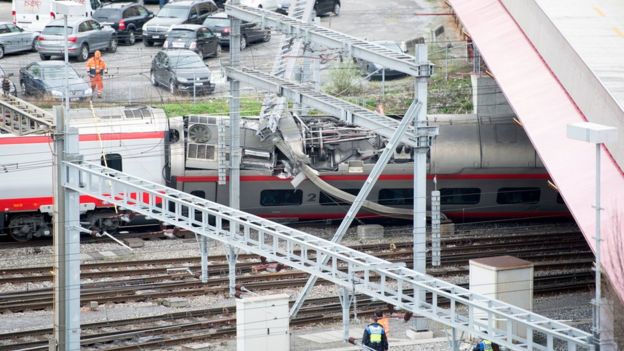 Image copyright EPA The train at Lucerne, Switzerland, had been carrying 160 passengers
At least three people were injured when a train derailed while pulling out of a station in Switzerland, officials said.
Passengers were initially trapped when a carriage tipped on to its side at the station in Lucerne. The incident occurred at about 14:00 local time (13:00 GMT) on Wednesday, Swiss Federal Railways (SBB) said. There were 160 passengers on board the train, owned by Italian operator Trenitalia, which was travelling to Basel from Milan, Italy. The fourth carriage of the train struck a power cable when it derailed, delaying rescue efforts, a spokesman for Lucerne police, Urs Wigger, said. Lucerne police said the passengers were evacuated and at least three people required treatment and were taken to hospital. Their injuries are not thought to be life-threatening. Services in and out of the station were suspended for the rest of the day, SBB said. The cause of the derailment was not immediately clear. Fortunately this happened at low speed, so injuries were quite minor. As you can see from the picture, it wasn't a cable that the train struck but an OHLE portal. That took out the whole station's traction power, so the disruption has been enormous. It's being reported as both "Eurocity" and "Cisalpino", but it doesn't look to me like one of the old tilting trains. Here's another picture, showing what a great place it's in for lifting by crane: 
|
|
|
|
|
 Logged
Logged
|
|
|
|
|


